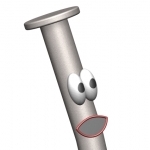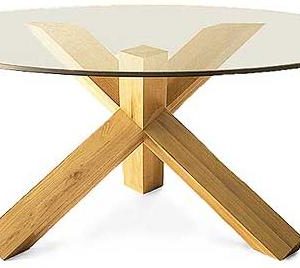Does anyone know how the joinery for this table base is made?
Discussion Forum
Get It All!
UNLIMITED Membership is like taking a master class in woodworking for less than $10 a month.
Start Your Free TrialCategories
Discussion Forum
Digital Plans Library
Member exclusive! – Plans for everyone – from beginners to experts – right at your fingertips.
Highlights
-
Shape Your Skills
when you sign up for our emails
This site is protected by reCAPTCHA and the Google Privacy Policy and Terms of Service apply. -
 Shop Talk Live Podcast
Shop Talk Live Podcast -
 Our favorite articles and videos
Our favorite articles and videos -
E-Learning Courses from Fine Woodworking
-
-
 Fine Woodworking New England Event
Fine Woodworking New England Event -














Replies
The two 1x legs would be a hlf-lap, with a square hole in the center. The square post is actually 2 pieces, the top ( or bottom) "half" would have a square "post" (tenon) that went through the half-lap and into the other half of the square post.
Thanks, It looks more complicated than it is!
dmdnkPlease see my post to whitedog aboveRich
A different view.
Edited 8/29/2009 8:05 am ET by Rich14
hmm . . .That didn't work - try again
Rich,
Thanks for the input. I did understand that the three members of the base would all be the same. Here's a shot of the drawing for the base.
Thanks,
David
I'm still not able to visualize this joint.
Can you draw this blown out so we can see how the joint works.
ASK
Yes, I'll draw it and post it when time permits.
David
Thanks
I'll be away until Sept 14 so don't rush on my account.
ASK
Theoretically, you can make this joint with 3 pieces of wood. It's a "burr" puzzle. A small version is shown in Wyatt's book Puzzles in Wood. I say theoretically as I don't know if one could or would want to make it furniture size. Two of the pieces have notches on two adjacent faces. The third is similar but instead of a square notch-out it is cylindrical. That allows you to rotate the piece and lock it in with the first two. Here is a screen shot from a burr puzzle site:
Now I get it.
Thank you
ASK
I don't think I can do it like the puzzle that Ben posted.... The legs on my table are 5"X5"! Here are the drawings of the way I plan to do the joinery.
David
Good solution.
whitedog.I believe you're mis-perceiving the tripod a bit. All three legs are equal in length and square cross-section. And they all cross each other at equal angles. There is not a "square post" and two 1x2 legs.The square post you describe is one of the legs seen in fore-shortened view and it's an optical illusion in that picture that it looks like it is a vertical square post. The other legs are seen in profile. The top of each leg is a diamond where it supports the glass top. The top of the leg you are calling a post is a diamond in fore-shortened view, looking like a square. If there were another picture with the table rotated slightly so that all 3 legs were in an oblique view, the optical illusion wouldn't exist. I believe the picture was taken that way not to deceive, but to give a kind of symmetry by lining up one the the legs (the "post") perfectly square to the camera position..I pretty much agree with your assumptions about the 3-way joint holding the tripod together, But I think the tenons in the leg that go through the lap joint need to be more elaborate than the construction you propose. I think each half of that leg needs to have both a mortise and a tenon, long and deep enough to go all the way through the lap joint and into the mating leg half for the joint to have enough strength.Something like the attached PDF.Rich
Edited 8/29/2009 7:56 am ET by Rich14
see Tage Freid's Book on Joinery where he makes a 4-way intersection - this may provide you w/ insight.
dlb
.
3x3 custom on Youtube actually dove in and figured out what it takes to create this type of joint... here is a link to the video. https://youtu.be/9vd2P0PeXB8
This forum post is now archived. Commenting has been disabled